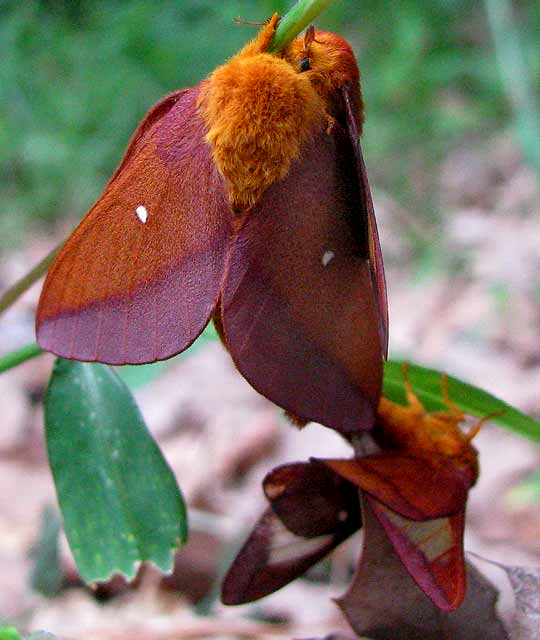Excerpts from Jim Conrad's
Naturalist Newsletter
from the June 3, 2012 Newsletter issued from the woods of the Loess Hill Region a few miles east of Natchez, Mississippi, USA
MOTH MATING FRENZY
Biking down an isolated little road deep in a bottomland forest I noticed several insects flitting among the roadside weeds. They were moths, presumably males, circling a much larger female clinging to a grass stem. One male already was mating with the female, opposite here on the grass stem, while a second male below tried to find his own place, as shown below.

That female must have been issuing some very potent pheromones -- excreted chemicals that trigger social response, often carried by the wind -- to have attracted such an excited group of suitors. As the stationary couple mated and the third lingered below, a fourth male landed on the mating male opposite the female, apparently trying to dislodge him and while he was doing that yet a fifth male glanced off him. Two other males flew around in circles, buzzing from time to time but having no luck at all.
At first glance volunteer identifier Bea in Ontario, who is becoming a genuine lepidopterist, recognized not only that the moths belonged to the Giant Silkworm Family, the Saturniidae, but also the Royal Moth Subfamily, the Ceratocampinae. It's always a treat to meet new Giant Silkworm Family members because most are very pretty and when you see one you know that the individual moth before you won't be alive long. Adult members of this family are little more than sex machines. They don't even have functional mouthparts, since all they are supposed to do is to have sex and die, the female needing to lay eggs before her death.
Bea pegged our roadside discoveries as Pink-striped Oakworm Moths, ANISOTA VIRGINIENSIS, pointing out that the forewings of males bear clear patches while those of females do not. In our picture you can see that this is true, the clear patches showing up clearly in the forewings of the frustrated male below the female.
At the Butterflies & Moths of North America website at https://www.butterfliesandmoths.org it's said that adults fly during the day and mate in the morning. After dusk, females lay eggs in groups on the undersides of oak leaves. Caterpillars feed together in groups, and pupate and overwinter in shallow underground burrows. In the adjacent bottomland forest, Water Oaks, Quercus nigra, were abundant.
Pink-striped Oakworm Moths are distributed from Nova Scotia west across the Great Lakes states to Manitoba and Minnesota, and south to central Florida, the Gulf Coast, and east Texas.